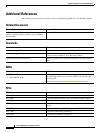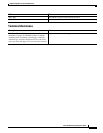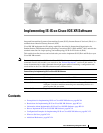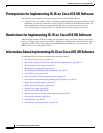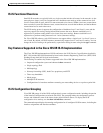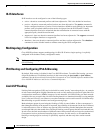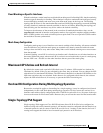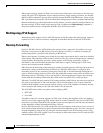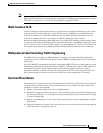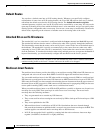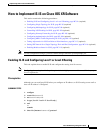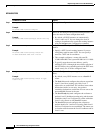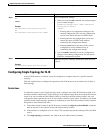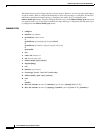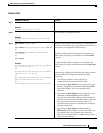
Implementing IS-IS on Cisco IOS XR Software
Information About Implementing IS-IS on Cisco IOS XR Software
RC-88
Cisco IOS XR Routing Configuration Guide
When single-topology support for IPv6 is used, only narrow link metrics, also known as old-style type,
length, and value (TLV) arguments, may be employed. During single-topology operation, one shortest
path first (SPF) computation for each level is used to compute both IPv4 and IPv6 routes. Using a single
SPF is possible because both IPv4 IS-IS and IPv6 IS-IS routing protocols share a common link topology.
Because multitopology is the default behavior in the software, you must explicitly configure IPv6 to use
the same topology as IPv4 enable single-topology IPv6. Configure the single-topology command in
IPv6 router address family configuration submode of the IS-IS router stanza.
Multitopology IPv6 Support
Multitopology IPv6 support on Cisco IOS XR software for IS-IS assumes that multitopology support is
required as soon as it detects interfaces configured for both IPv6 and IPv4 within the IS-IS stanza.
Nonstop Forwarding
On Cisco IOS XR software, NSF minimizes the amount of time a network is unavailable to its users
following a route processor (RP) failover. The main objective of NSF is to continue forwarding IP
packets and perform a graceful restart following an RP failover.
When a router restarts, all routing peers of that device usually detect that the device went down and then
came back up. This transition results in what is called a routing flap, which could spread across multiple
routing domains. Routing flaps caused by routing restarts create routing instabilities, which are
detrimental to the overall network performance. NSF helps to suppress routing flaps in NSF-aware
devices, thus reducing network instability.
NSF allows for the forwarding of data packets to continue along known routes while the routing protocol
information is being restored following an RP failover. When the NSF feature is configured, peer
networking devices do not experience routing flaps. Data traffic is forwarded through intelligent line
cards or dual forwarding processors (FPs) while the standby RP assumes control from the failed active
RP during a failover. The ability of line cards and FPs to remain up through a failover and to be kept
current with the Forwarding Information Base (FIB) on the active RP is key to NSF operation.
When the Cisco IOS XR router running IS-IS routing performs an RP failover, the router must perform
two tasks to resynchronize its link-state database with its IS-IS neighbors. First, it must relearn the
available IS-IS neighbors on the network without causing a reset of the neighbor relationship. Second,
it must reacquire the contents of the link-state database for the network.
The IS-IS NSF feature offers two options when configuring NSF:
• IETF NSF
• Cisco NSF
If neighbor routers on a network segment are NSF aware, meaning that neighbor routers are running a
software version that supports the IETF Internet draft for router restartability, they assist an IETF NSF
router that is restarting. With IETF NSF, neighbor routers provide adjacency and link-state information
to help rebuild the routing information following a failover.
In Cisco IOS XR software, Cisco NSF checkpoints (stores persistently) all the state necessary to recover
from a restart without requiring any special cooperation from neighboring routers. The state is recovered
from the neighboring routers, but only using the standard features of the IS-IS routing protocol. This
capability makes Cisco NSF suitable for use in networks in which other routers have not used the IETF
standard implementation of NSF.



